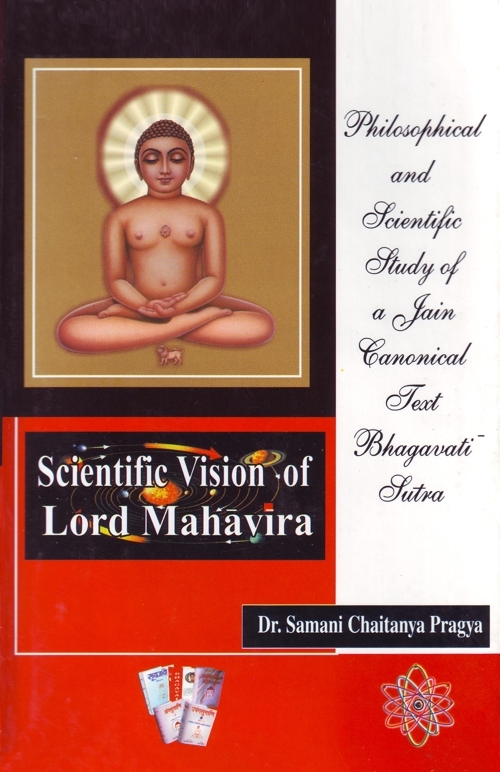The Bh.S mentions the order of the universe in a well-confined manner. According to it, the universe is not chaos but it has a systematic and static universal order. As far as the structure is concerned the universe is surrounded by fourfold layers. Once the disciple Indrabhuti Gautama asked Mahāvīra—"how many strata are there, O Lord! in the cosmos?" The answer was, "there are eight strata". The strata are as follows:—
- The air rests on space
- The ocean rests on the air
- The earth rests on the ocean (water)
- The mobile and immobile creatures rest on the earth
- The non-souls rest on the souls
- The souls rest on karma
- The non-souls are seized by the souls
- The souls are seized by the karma."[101]
In this discussion eight strata have been described keeping the whole picture of the universe in view. The first four strata have been dealt with to describe the structure of the universe. Accordingly, the sentience—mobiles and immobile are based on the earth, the earth is based on the ocean, the ocean is based on the air and the air is based on space. (See figure-9) The rest four are not concerned with the structure of the universe but are of paramount importance from the viewpoint of mutual effect of physical and non-physical elements upon each other.
Again it is said that the air is based on the space. The question is what about the space? The Vṛtti,[102 ]a commentary on the Bh.S explains that the space rests on itself so there is no need of anything to support it. The thing noticeable here, according to the Vṛtti, is that the earth rests on the ocean. This however is to be understood as such with an exception because the land that is the abode of the liberated souls does not rest on the ocean but on the space.[103] Like-wise, the mobile and immobile beings rest on the earth. This also has an exception because some creatures also rest on space, mountains and space-vehicles. It shows that whatever has been said in the scriptures should be taken in a relative sense and not in an absolute sense. The last four strata give some glimpse of how the universe is going on and how the physical objects depend on the non-physical, i.e., the soul and vice-versa, and how the multiformity of universe takes place by a symbiotic relationship of the physical and non-physical objects.
When it is said that non-souls rest on souls; here non-souls, according to the Vṛtti,represent the material body of the soul and the like which rest on souls.[104] The implication is that the varieties of physical world and its transformations that are taking place are due to activities of the soul. Whatever is visible in the world is either living bodies or dead bodies left behind by the souls. It is in this sense that the non-souls rest on the soul. On the other hand, whatever varieties and whatever changes and formations are seen of soul, all of them are due to karma. The Bh.S states that all these are the result of karma (subtle karmic matter). Hence, it has been stated that the soul rests on karma.[105]
Further, the last two strata i.e. the non-soul is seized by the soul and the soul are seized by the karma, prove that there should be something similar due to which immaterial and material (whether it is karma or physical body et.) can seize one another. The Bh.S mentions that similarity by the name affection, (sneha).[106] This quality is responsible for the relationship between the immaterial and material objects. With the help of it both the physical and non-physical entities cause various transformations in one another.
Besides, the last two strata also throw light on the relationship between soul and matter or mind and body, which has been a long-standing problem before the philosophers as well as the scientists. As far as the Bh.S is concerned, it does discuss this problem and suggests some solution that has been dealt with at length in the sixth chapter.
With a view to explain the order of strata in the above-said manner Lord Mahāvira has given two similar examples as follows:[107]
"Suppose a person fills a leather bag with air and ties its mouth tightly with a thread. Then he ties a knot in the middle, and then unties the upper knot. He empties it of the air from the upper open part. Then he fills the upper part with water and ties the end of it with a thread. Then he unties the middle knot. In result, the water rests upon the air.
In another example, a person fills a leather bag with air and ties it to his waist. After he dives into deep, uncrossable and unfathomable waters. But he will float on and not get immersed into the water because of the help of the upward force of the bag. These illustrations show how the air is resting on space, the ocean is resting on air, the earth is resting on ocean and the sentients are resting on earth (See figure-7).
Bh.S; 1/6/310—kativihā ṇaṃ bhante! loyaṭṭhidi paṇṇattā? Goyamā! aṭṭhavihā loyaṭṭhiti paṇṇattā, taṃ jahā—1.āgāsapaiṭṭhie vāe, 2. vāyapaiṭṭhie udahi, 3. udahipaiṭṭhiya puḍhavi, 4. puḍhavipaiṭṭhiya tasasthāvarā pāṇā, 5. ajīvā jīvāpaiṭṭhiyā, 6. jīvā kammapaiṭṭhiya, 7. ajīvā jīvāsangahiya, 8. jīvā kammasangahiya. (ii) Sthānāṅga; 3/319
 Dr. Samani Chaitanya Pragya
Dr. Samani Chaitanya Pragya



